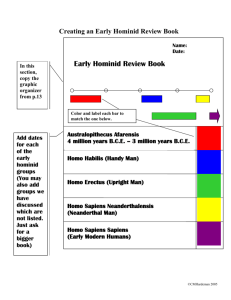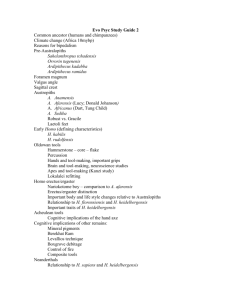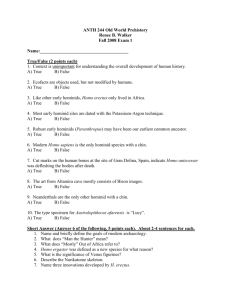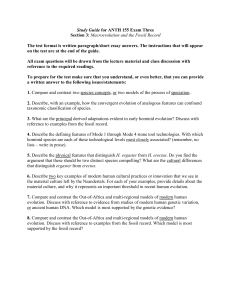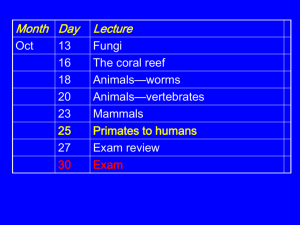H. sapiens - Lincoln High School
advertisement
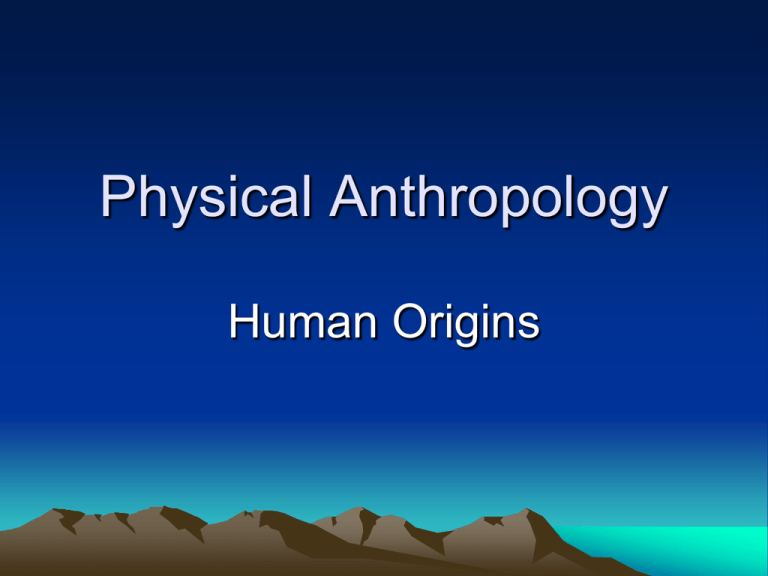
Physical Anthropology Human Origins What is a Mammal? • Class Mammaliaair-breathing vertebrate animals characterized by the possession of endothermy, hair, three middle ear bones, and mammary glands. • Most mammals also possess sweat glands and specialized teeth, and the largest group of mammals, the placentals, have a placenta which feeds the offspring during gestation. Mammal Origins • The first mammals evolved from Therapsids, mammal-like reptiles, at the end of the Triassic period (248-213 mya), and coexisted with dinosaurs throughout the Mesozoic Era (248-65 mya). • It was only after the dinosaurs went extinct that mammals were able to evolve beyond their tiny, mouse like forms into the widely specialized species that populate the world today. • Therapsids-mammal like reptiles Early mammals characteristics: 1. enlarged brain; more developed sense of smell & hearing 2. warm blooded 3. nocturnal 4. specialized teeth (4 types) 5. may have laid eggs (like extant monotremes) 6. skeletal changes permit more flexibility & faster motion 7. larger lungs for faster breathing Earliest Mammals |←--------- 4-5 inches long ----------→| • Megazostrodon- extinct Mammaliaform, widely accepted as being one of the first mammals, appearing in the fossil record approximately 200 million years ago, is likely to represent the final stage of the transition between cynodont, or "mammallike" reptiles and true mammals. Coelacanth; a living fossil Living Mammal Ancestors Platypus & Echidna: • Monotremes- means “onehole”, refers to presence of “cloaca”, which serves purpose of urination/defecation & reproduction (reptiles, birds). • Primitive, egg-laying mammals that nourish their newly hatched young with milk produced from modified sweat glands. • Only found in Australia & New Guinea. The next step: Marsupials • Marsupials- pouchedmammals with short gestation periods due to yolk-type placenta, giving birth to underdeveloped live young. • More common than placental mammals during Mesozoic era, declined at mid to late Tertiary period. • Still common in Australia & South America. S. American populations decline after land bridge connecting N. America introduces placental mammals during late Miocene, early Pliocene. Eutheria: placental mammals -Placenta, connected to mother’s bloodstream, directly nourishes young to advanced stage. -large opening at bottom of pelvis for birth of larger, more developed young. -loss of epipubic bones (present monotremes, marsupials) which interfere with enlargement of abdomen during gestation -oldest known fossil dates back to 160 mya. Monotreme vs. Marsupial vs. Placental • For all or the above: 1. List all the advantages of each group. 2. List the disadvantages of each group. 3. Teacher will pick you to defend 1 group. • Note: to be able to defend your advantages you must be familiar with the advantages/disadvantages of the other 2 choices. Order: Primates • Category of Mammals with: -flexible hands & feet -forward-looking eyes, which allows for excellent 3-D vision -enlarged brains relative to body size -can rotate arm in a circle around shoulder joint -many have opposable thumbs Examples: -smallest = mouse lemur (1 oz.) -largest = mountain gorilla (440 lbs.) Primate evolution & origins: • Primates evolved from mammals of the late Cretaceous (c. 65 mya). • Oldest know primate is Plesiadapis , c. 55-58 mya. • Most likely a tree-dweller, it is, however, found in high numbers suggesting ground-dwelling. • Eyes not completely forward facing. • Teeth similar to rodents (large incisors) but with grinding & crushing molars for omnivority. Prosimians “before ape” Oldest living primate group • Loris- nocturnal, found in forests/woodlands of S.E. Asia, slow-moving, omnivores & insectivores, “allergenic” slightly toxic saliva gathered from brachial gland & applied to young when left in nest, wet nose, nails instead of claws, tooth comb. Slender Loris Slow Loris Prosimians • Lemur- name means “ghost”, all found in Madagascar arriving 6265 mya on vegetation rafts, thought to have evolved from lorisiforms 50-55 mya, very diverse (100 species) with many overlapping same terrain but occupying different niche, size range 1oz.-20lb. (400lb. extinct lemur!), eyes not completely forward facing, wet-nose, nails instead of claws, “tooth comb” used for grooming/feeding, “toilet claw” longer second toe used for scratching. Prosimians • Tarsier- found in S.E. Asia, considered “early” monkeys, one eyeball as big as entire brain and with different connections compared to other primates, elongated tarsus (foot) bones give its name, elongated fingers with longest = to forearm, toilet claw, lack toothcomb, although many nocturnal they lack light reflecting membrane, all carnivores with most being insectivores. What does it mean to be human? • What qualities/traits set us apart from other ape, monkeys and hominids that have existed on earth so far? The first Hominid? Sahelanthropus tchadensis • • • • • • • “Toumaï”- Extinct hominin species dated to about 7 million years ago. Arguments for and against inclusion in Hominid family. Older than human-chimpanzee divergence (6.3 to 5.4 million years ago). Braincase volume = 320 cm³ to 380 cm³ Anteriorly placed foramen magnum Ape-like U-shaped dental arcade, Hominid-like smaller canines Is it related to Ardipithecus? Orrorin tugenensis: “Original Man” 2nd oldest fossil hominid found to date • Fossil specimens estimated to be 6 to 5.8 million years old • Small teeth relative to body size, but thicker enamel (Ardipithecus?) canines ape-like but reduced • Bipedal, but grasping hands (curved fingers) suggest tree climbing, arboreal grasping hallux (big toe). • Femur more similar (?) to humans (may be more direct human ancestor than “lucy”!) • Pushes great ape/hominid split to at least 7 million years Ardipithecus kadabba & Ardipithecus ramidus Ardi = “ground floor” Pithecus = “ape” Ramidus = “root” • A. kadabba, 5.6 mya • A. ramidus (“Ardi”) - 4.4 mya, bipedal but with arboreal grasping hallux (big toe), reduced canines, brain size similar to modern chimps (300 and 350 cm3), generalized dentition suggests omnivory & frugivory, less sexual dimorphism points to less male to male competition, more pair bonding, more parental investment. • Inhabited mosaic of woodland and grasslands. Genus Australopithecus • • • • • Common ancestors to all great apes? Australopithecines: “southern apes” 35% brain capacity of modern humans Bipedal hominids between 3ft. 10in. – 4ft. 7in. tall Substantial dimorphism: in humans males are ~15% larger than females, Australopithecine males may have been 50% larger. Oldest fossils ~4 mya. Is dimorphism alone enough to determine whether a hominid is more ape-like or humanlike? Australopithecus (Praeanthropus) afarensis • A. (P.?) afarensis- “Lucy” • Fossil range ~3.9-3.2 mya • Reduced canines and molars, although still relatively larger than in modern humans • Brain case ~380–430 cm3 • First proof that larger brain size was not necessary for bipedalism. • No grasping toe, although curvature of fingers and toes similar to great apes. • Evidence of stone tool using Australopithecus africanus Very likely our oldest direct ancestor? • Lived ~3.0 - 2.4 mya • ~485 cm3 cranial capacity (largest Australopithecine brain is A. ghari ~600 cm3) • Pelvis more suited for bipedalism than A. afarensis, but has curved climbing fingers. • May lead directly to Paranthropus or Homo or both? • Slightly less sexual dimorphism possibly as adaptation of females to bear load of pregnancy while upright. Genus Paranthropus- “robust australopithecines” Greek phrase meaning “beside human” • First appear ~2.7 mya • Bipedal apes descended from Australopithecines • Stood 4ft 3in - 4ft 7in, brain case ~500-550 cm³ • Side branch to genus “Homo”, inhabiting more wooded areas • More dedicated herbivore, similar to gorillas; – sagital crest, large dentition; skull highly specialized for heavy chewing P. aethiopicus P. boisei and P. robustus • High sexual dimorphism: – Males 68 kg (150 lb) and stood 1.3 m (4 ft 3 in) tall, Females weighed 45 kg(99 lb) and stood 1.05 m (3 ft 5 in) tall • Molars have twice the area of human molars with most enamel of any hominid P. Boisei “Nutcracker man” Fossil range ~ 2.3-1.2 mya Genus Homo: homo means “same” • Oldest examples from about 2.3 - 2.4 mya • Genus Homo was originally distinguished from previous genus by use of stone tools, but newer evidence puts tool use as early as 3.39 mya. • Emergence of Homo coincides roughly with the onset of Quaternary glaciation, the beginning of the most recent ice age. • All species in genus Homo extinct expect Homo sapiens; us. Homo gautengensis the earliest member of genus Homo? • Dating to about 2.5 mya, believed to be the transitional species between genus Australopithecus and genus Homo. • Cranial capacity probably ~ 600 cm³, just over 3 ft tall and about 110 lbs, probably very similar to Australopithecines; bipedal on ground and spending considerable time in trees. • Was "small-brained" and "large-toothed”, probably relying on vegetable matter for majority of diet. • Produced and used stone tools and may even have made fire. H. habilis & H. rudolfensis • H. habilis “handy man” 2.33 - 1.4 mya • Brain size: ~710 cm³ • Less prognathism than previous Homo species, molars reduced in size and elongated suggesting more varied diet • May or may not be first tool maker, but hand/finger bones shorten and evolve for finer precision • Most likely used to tools to scavenge carrion and not necessarily for hunting • Debate as to differences between two species and which is direct ancestor to Homo sapiens H. Ergaster –”workman” • 1.8 -1.3 mya • 700-900 cm³ brain case, ~6ft tall • Evolves in Africa from H. habilis; debate continues on whether H. ergaster is just early H. erectus, or H. ergaster leaves Africa and becomes H. erectus in Asia. • Probably 1st hominid to harness fire, although most likely not created. • Less sexual dimorphism = less male competition, more social organization, larger brains, more sophisticated tools. • Probably 1st hominid to use “human” voice • H. ergaster likely continues lineage to modern humans • See H. erectus for more info * H. Erectus (from/with H. ergaster?) • • • • • • • • • 1.89 million - 143,000 years ago Brain case ~ 850-1100 cm³ Able to vocalize, “proto-language.” *Probably first hominid to live in small, familiar band-societies similar to modern hunter-gatherers. *First hominid to hunt in coordinated groups, use complex tools, and care for infirm or weak companions. *May be first hominid to light fire Populates Asia & Europe Longest lived hominid to date Possible “side branch” to H. ergaster? H. mauritanicus/antecessor • 1.2 million to 800,000 years ago • Brain case ~ 1,000 cm³ , 5.5-6ft tall, 200 lb., more robust than H. heidelbergensis • Descendant of H. ergaster in Europe, or early H. heidelbergensis? • Most likely 1st hominid in Northern Europe • Language (left brain) development leads to righthandedness (?) • Evidence from European fossils points to cannibalism H. Heidelbergensis from/with(?) H. mauritanicus/antecessor • 600,000 – 250,000 yrs ago • Similar to H. ergaster but because of larger brain-case (1100–1400 cm³) and more advanced tools and behavior, given separate species name. • European populations tall (~6ft), African populations Giant (~7ft) • Most likely has true, albeit primitive, language due to similarities to human auditory sensitivities • First hominid to bury their dead • May be 1st to hunt with projectiles • European populations evolve into H. neanderthalensis, African populations into H. sapiens. H. neanderthalensis • • • • “Neanderthal Man” 200,000 – 25,000 years ago ~1450 cm³ brain case Shorter, but more robust with strong arms/hands: males ~5’6”, females ~5’1” • Only found in Eurasia, well adapted to cold weather. • Evidence points to interbreeding w/ H. sapiens between 80,000 and 50,000 years ago (1-4% of Eurasians have H. neanderthalensis genes) • Debate as to whether extinction is caused by climate change and/or volcanic activity, competition w/ H. sapiens, or both, or genetically absorbed into H. sapiens. Genus Homo: possible lineage scenarios 1. H. habilis H. ergaster H. erectus H. floresiensis H. heidelbergensis H. sapiens H. neanderthalensis 2. H. ? H. habilis H. ergaster H. erectus H. mauritanicus H. heidelbergensis H. sapiens H. neanderthalensis 3. H. ? H. habilis H. rudolfensis H. ergaster H. heidelbergensis H. sapiens H. erectus H. neanderthalensis 4. H. habilis H. erectus H. mauritanicus H. neanderthalensis H. heidelbergensis H. sapiens 5. H. habilis H. ? H. ergaster H erectus H. heidelbergensis H. sapiens 6. H. ? H. habilis H. neanderthalensis H. ergaster H. erectus H. mauritanicus H. heidelbergensis H. sapiens H. neanderthalensis

